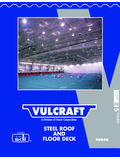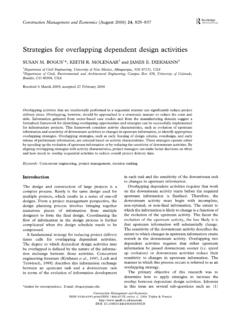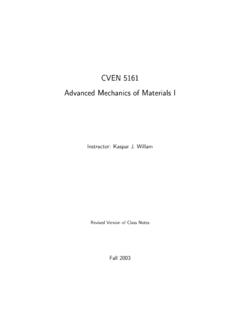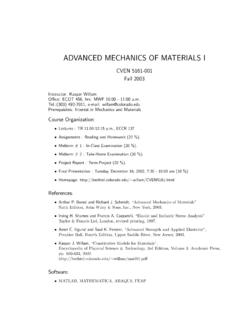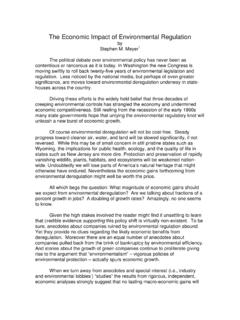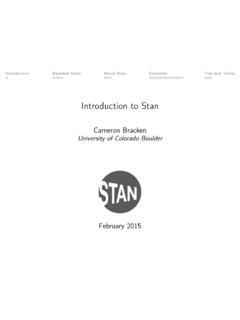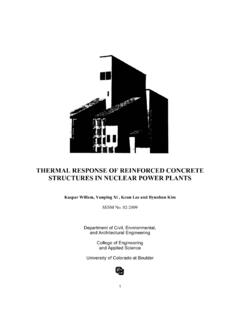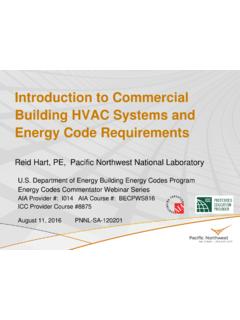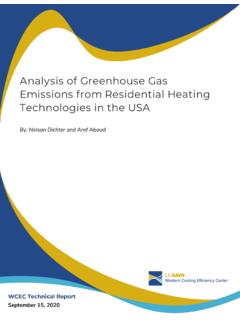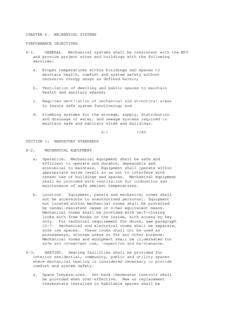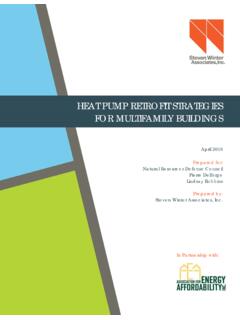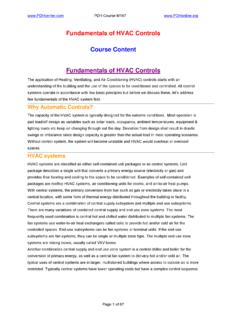Transcription of SECOND LAW OF THERMODYNAMICS
1 SECOND LAW OF THERMODYNAMICS INTRODUCTION AND CYCLES You could say that the 2nd Law was developed because physicists observed that there were phenomena that were not explained by the 1st law. There are various formulations and applications of the 2nd Law. We will study two of them that relate to important cycles using pure substances in simple compressible systems. 1. An electric resistance heater has current (work) passed through a resistance (wire) and produces heat electricity (work) heat Neglecting changes to the wire, the 1st law for the heater is: Q = W The 1st Law does not say anything about the direction of the energy transfer.
2 In fact, according to the 1st law, we could reverse the arrows, heat the wire, and produce electricity. However, you know from experience that this cannot be done. So there are some kinds of energy transfers allowed by the 1st law that do not occur in nature, and continuously producing work from heat is one. (You can produce work once by adding heat to a piston cylinder, but the process will stop when the piston reaches the top of the cylinder.) 2. If you place a cold can of soda in a warm room, it is easy to predict that heat will be transferred from the warmer surroundings to the soda.
3 The 1st law statement for the soda in this passive process (no work) is: Q = U Where Q is positive and the system gains energy. However, the 1st law does not say that the process 20 oC 5 oC Q 1could not be reversed with heat transfer from the can to the room and decrease in the energy of the soda. But we know from experience that heat is never transferred spontaneously from a cold system to warm surroundings. These are examples of two principles addressed by the 2nd Law of THERMODYNAMICS : 1. SOME PROCESSES CAN OCCUR SPONTANEOUSLY ONLY IN ONE DIRECTION.
4 HEAT TRANSFER IS A DIRECTIONAL PROCESS, AND HEAT WILL ONLY BE TRANSFERRED FROM HIGH TEMPERATURE TO LOW TEMPERATURE. 2. ENERGY HAS A HIERARCHY. WORK (MECHANICAL, ELECTRICAL, CHEMICAL, ETC.) IS HIGHER QUALITY ENERGY THAN HEAT. FURTHERMORE, THE QUALITY OF ENERGY ALWAYS DECREASES IN THERMODYNAMIC PROCESSES. THIS MEANS THAT WORK CAN ALWAYS BE CONVERTED TO HEAT, BUT HEAT CANNOT BE CONVERTED DIRECTLY TO WORK. All thermodynamic processes must satisfy both the 1st and 2nd Laws. DEFINITION THERMAL RESERVOIR A thermal reservoir is a body that can supply or absorb heat without changing temperature.
5 A) Could be a large mass with high heat capacity (mCp): ocean, atmosphere b) Could be a smaller two-phase system that boils/condenses or freezes/melts at constant temperature HIGH TEMPERATURE RESERVOIR IS A SOURCE THAT CAN SUPPLY HEAT TO A SYSTEM WHILE IT STAYS AT A CONSTANT TEMPERATURE LOW TEMPERATURE RESERVOIR IS A SINK THAT CAN ABSORB HEAT WITHOUT CHANGING TEMPERATURE. 2WE WILL STUDY TWO CYCLES FOR SIMPLE COMPRESSIBLE SYSTEMS CONTAINING PURE SUBSTANCES RELATED TO THE TWO PRINCIPLES STATED BEFORE ABOUT HEAT TRANSFER DIRECTION AND ENERGY QUALITY.
6 1. HEAT ENGINES 2. REFRIGERATORS 1. HEAT ENGINES ARE CYCLES FOR CONVERTING HEAT TO NET WORK CONTINUOUSLY. Characteristics of heat engines: a) a heat engine receives heat from a high temperature reservoir or SOURCE (furnace, sun, fission reaction, etc) b) A fraction of the heat input is converted to NET WORK (mechanical directly) c) The remaining fraction of the heat input must be rejected to a low temperature reservoir or SINK. d) Heat engines operate in a cycle so the 1st law statement for the heat engine cycle is: QNET = WNET e) the medium in a heat engine process is a fluid, called the working fluid.
7 Working fluid can be water/steam, air, R-134a, etc. Analysis of Heat Engines Net work = WNET = WOUT WIN Since a heat engine is a cyclic process, the change in energy of the working fluid = 0. Net heat transfer = QNET = QIN QOUT From the 1st Law: QNET = WNET From the 2nd law: QOUT > 0 3A HEAT ENGINE PROCESS IS CHARACTERIZED BY ITS EFFICIENCY, =networkproducedheat input=WnetQin However, WNET = QNET = QIN QOUT and substituting into above =Qin QoutQin=1 QoutQin 0 < < 1 If only the 1st law controlled, could equal 1. However, by the 2nd law, since QOUT > 1, then < 1.
8 QIN is the heat input from the high temperature reservoir (HTR), and QOUT is the heat rejected to the low temperature reservoir (LTR). HTR QINLTR QOUTWNETHE Conceptual sketch: 4 EXAMPLE 1 A steam power plant receives 280 GJ/hr from a furnace. Heat is rejects at the rate of 145 GJ/hr and there is an additional 8 GJ loss through the pipes of the plant. a) What is the net power output from the plant? )jr/GJ(8145280QW3netnetnet= = ==&&& b) What is the plant efficiency, ? )8145( + = = === &&&& EXAMPLE 2 A solar power plant has an efficiency of and a net power output of 100 kw.
9 At what rate must solar heat be collected for this plant? kw333, ==&&& At what rate is heat rejected? kw233,3kw100333,3 QQQQQWLLHOUTINNET= = = =&&&&&& 5 KELVIN-PLANCK STATEMENT OF THE 2ND LAW PERTAINING TO HEAT ENGINES: It is impossible for any device operating in a cycle to receive heat from only one reservoir and produce a net amount of work. 62. REFRIGERATOR (OR HEAT PUMP) IS A DEVICE TO TRANSFER HEAT FROM A LOW TEMPERATURE MEDIUM TO A HIGH TEMPERATURE MEDIUM. HTR QINLTR QOUTWINR efrig. Characteristics of Refrigerators/Heat Pumps a) Refrigerator/heat pump receives heat from a low temperature medium (ice box of refrigerator, outdoor air, etc.
10 B) Heat is rejected to a high temperature medium (room air). c) Cycle requires work input d) 1st Law statement WIN = QOUT - QIN e) Working fluid is special chemical that boils at low temperatures and near atmospheric pressures (R-134a) 7 Analysis of Refrigerators/Heat Pumps The term to describe the performance of refrigerators is the COEFFICIENT OF PERFORMANCE (COP) COP=desired outputrequired input for a refrigerator, the desired output is the heat removed from the cold medium and the required input is work: COPR=QinWinbutWin=Qout QinCOPR=QinQout Qin=1 QoutQin 1=1 QHQL 11<QHQLand often<2 then typically, COPR >1 (different from ) (QH = heat rejected to high temperature medium and QL = heat input from low temperature medium.
